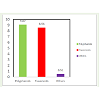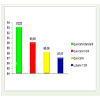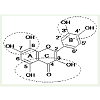Research Article
Antioxidant Activity of Flavonoids Isolated from Rosmarinus officinalis L.
Zeghad Nadia1*, Merghem Rachid1
1Laboratory of the development and utilization of Genetic Resources of plants, Faculty of natural sciences and life.Constantine1, Algeria
Corresponding author: Zeghad Nadia, Laboratory of the development and utilization of Genetic Resources of plants, Faculty of natural sciences and life. Constantine1, Algeria; E-mail: zeghadsofia@yahoo.fr
Citation: Zeghad Nadia, Merghem Rachid.Antioxidant Activity of Flavonoids Isolated from Rosmarinus officinalis L. J Plant Sci Res. 2016;3(1): 142.
Copyright © 2016 Nadia Z et al, et al. This is an open access article distributed under the Creative Commons Attribution License, which permits unrestricted use, distribution, and reproduction in any medium, provided the original work is properly cited.
Journal of Plant Science & Research | ISSN: 2349-2805 | Volume: 3, Issue: 1
Submission: 31/01/2015; Accepted: 15/02/2016; Published: 22/02/2016
Abstract
Rosmarinus officinalis L. (Lamiaceae), Rosemary is recognized several years ago in the traditional medicine by its therapeutic virtues and its ability to treat some diseases, in this context the present study aim to determine the content of phenolic and flavonoid compounds contained in Rosmary leaves and to evaluate their antioxidant activity. The total phenolic and flavonoid contents were estimated by the methods of Folin-Ciocalteu and AlCl3 methodsrespectively. Diagnosis and isolation of flavonoids have been carried out by various chromatographic techniques (Thin layer chromatography and Column chromatography) and their structural identification was carried out by spectral analysis by the spectrophotometer (UV-Vis). The antioxidant capacity was evaluated by in vitro trapping of free radical DPPH. The total polyphenols and flavonoids contents in rosemary were 10.42 mg GAE/g of dry material for polyphenols and 9,075±0,002 mg QE/g of dry material for flavonoids. The chromatographic and spectral identification of extracts of thyme revealed the presence of three flavonoids characterized by their antioxidant activity in the order of 90%, 88%, 87% respectively for quercetin 3OR, quercetin, and luteolincompared to quercetin standard characterized by its percentage of scavenging DPPH equivalent to 93.05%.
In conclusion, we report that the flavonoids of R. officinalis exhibit good antioxidant activity against free radicals. The molecules may be used as antioxidants and for therapeutic applications.
Keywords: Rosmarinus officinalis; Flavonoids; Thin layer chromatography; Column chromatography, spectrophotometer (UV-Vis); antioxidant activity
Introduction
Species and herbs have been added to foods since ancienttimes, mainly to modify or to improve their flavor. Since 1952, theantioxidant properties of some of these species have been recognized.Antioxidants are compounds that when present in foods at lowconcentrations, compared to the concentration of an oxidizablesubstrate markedly delay or prevent oxidation of the substrate.Among the species with antioxidant properties, usage of rosemaryhas increases tremendously in many food applications [1].
Rosmarinus officinalis L. belongs to the Lamiaceae family of herbs,which is not only useful as a food flavoring agent and preservative butalso for its powerful antibacterial, antimutagenic properties,and as achemopreventive agent [2].
Owing to its antioxidant properties, R.officinalis has been widelyaccepted as one of the species with the highest antioxidant activity [3].
In this paper, we report the results of a study aimed to evaluateand compare the in vitro antioxidant properties of some R. officinalisusing quercetin standard.
Material and Methods
Plant material, extraction and isolation
R. officinalis leaves were collected from Constantine, Algeriain March 2008. Taxonomic identification was performed by Prof.Merghem R, department of Biology and Ecology, at UniversityMentouri of Constantine, Algeria.
The plant material was dried at room temperature and groundin a mortar. Sample of 100 g of dried leaves of Rosmarinus officinaliswas extracted by ethanol/water (30:70) for 24 h at room temperature,the remaining vegetal marerial was extracted twice under identicalcondition [4]. The combined extract was concentrated under reducedpressure and dissolved in distilled H2O. The solution successivelywas partitioned with petroleum ether, ethyl acetate (EtOAc), andbutanone (BuOH). The ethyl acetate (EtOAc) and butanone (BuOH)dried extracts were dissolved in methanol, combined together andsubjected to column chromatography on polyamide. The columnwas eluted with a gradient of toluene-MeOH, provided 172 fractionsof 25 ml each. All fractions were chromatographed on thin layerchromatography polyamide DC6. As result, six flavonoids wereobtained and their purity was monitored by thin layer chromatographyon polyamide or silica gel.
Total phenol determination
The total phenolic compounds were determined by Folin-Ciocalteu reagent [5]. Calibration curve was prepared by mixingethanolic solution of tannic acid (1ml; 0.01-0.1 mg/ml) with 5mlFolin-Ciocalteu reagent (diluted tenfold) and sodium carbonate (4ml,0. 7M). We measured absorbance at 765 nm and drew the calibrationcurve. One ml of ethanolic extract (0.05 mg/ml) was also mixed withthe reagents above and after two hours the absorbance was measuredto determine total plant phenolic contents. All determinations werecarried out in triplicate. The total content of phenolic compoundsin the extract in Gallic acid equivalent (GAE) was calculated by thefollowing formula:
T=C.V/M
Where T: Total content of phenolic compounds, milligram pergram extract, in TAE.
C: Concentration of tannic acid established from the calibration curve, mg/ml.
V: Volume of extract (ml).
M: Weight of ethanolic plant extract (g).
Total flavonoids determination
Aluminum chloride colorimetric method was used for flavonoidsdetermination [6]. Two ml of 2% AlCl3 in ethanol was added to 2 ml ofthe test sample and the UV absorption was measured at 420 nm afterone hour at room temperature. Sample solution of concentration of0.05 mg/mL was used while quercetin concentrations of (0,01- 0,1)mg/ml were used to obtain a calibration curve. Determinations wereperformed in triplicates. Total flavonoid contents were obtainedfrom the regression equation of the calibration curve of quercetin(Y=0,1085x, r2=0,96).
vvThe stable DPPH 1,1-diphenyl-2-picryl hydrazyl radical was usedfor determination of free radical scavenging activity of the isolatedflavonoids from the extract of Rosmarinus officinalis [7]. Briefly, 50μl of methanolic solution containing the compound to be tested wereadded to 5 ml of a 0,004% methanolic solution of DPPH. The studiedcompounds were tested with MeOH as control and quercetin asantioxidant reference and absorbance at 517 nm was determined after30 min. The absorbance (A) of the control and samples was measuredand the DPPH scavenging activity in percentage was determined asfollow:
DPPH scavenging activity (%) = [(Acontrol-Asample)/ Acontrol] x100
The data are presented as mean of triplicate.
Results and Discussion
Total phenolic and flavonoids contents determination
The amount of total phenolic contents was 10.42mg GAE/g ofdry material. This result is comparable to one obtained by MuchuwetiFigure 1: Phenolic and flavonoids contents in rosemary (R. officinalis) et al. [8], who studied the content of phenolic compounds in Zimbabwe’s rosemary and obtained 10.83 mg GAE/g of dry material.The flavonoid contents in the extract of R. officinalis in terms ofquercetin equivalent were 9.075±0.002 mg QE/g of dry material. Ourexperiment revealed flavonoids were present in the highest amountin the rosemary plant and this compound which contain hydroxylsis responsible for the radical scavenging effect in plants (Figure 1),[9,10].
Antioxidant activity of the isolated flavonoids
The stable free radical DPPH method was used to determine theantioxidant activity of the isolated flavonoids. This method is an easy,rapid, and sensitive way to survey the antioxidant activity of a specificcompounds or plant extracts [11].
The isolated flavonoids obtained were tested for their antioxidantscavenging effects on DPPH radical and their activity was comparedto quercetin standard used as antioxidant reference. The resultsobtained at a concentration of 5 mg/ml are given in Figure 22 andexpressed as the percentage of the scavenging activity of DPPH.
Figure 2: Percentage of the scavenging activity of DPPH by the isolated flavonoids from R. officinalis.
The result demonstrated that all the compounds tested presents agood radical scavenging activity.
The major flavonoids isolated from R.officinalis are quercetinand luteolin, to which are attributed many of the antioxidantproperties, due to their hydrogen donation ability, and theirstructural requirement considered to be essential for effective radicalscavenging, it has been reported that this activity may result from:
• The presence of a 3’, 4’-dihydroxy, i.e., an o–dihydroxygroup (catechol structure) in the B ring, possessing electrondonating properties and being a radical target.
• The 3-OH moiety of the C ring is also beneficial for theantioxidant activity of flavonoids.
• The C2-C3 double bond conjugated with a 4-keto group,which is responsible for electron delocalization from the Bring, enhances further the radical-scavenging capacity.
• The presence of both 3-OH and 5-OH groups in combinationwith a 4-carbonyl function and C2-C3 double bond.
• The presence of hydroxyl substituents in a catechol structureon the A-ring were able to compensate the absence of theo-dihydroxy structure in the B-ring, and became a largerdeterminate of flavonoid antiradical activity (Figure 3).
Conclusion
R.officinalis is an important source of phenolic compounds andthe present study confirms the extract of this plant contains a highamount of flavonoids consisting of quercetin 3 OR, quercetin, andluteolin 7 OR. In this context, rosemary can be used as an easilyaccessible source of natural antioxidants in commercial food productsand drugs.
References
- Cavero S, Jaime L, Martin-Ălvarez PJ, Señoráns FJ, Reglero G, et al. (2005) In vitro antioxidant analysis of supercritical fluid extracts from rosmary (Rosmarinus officinalis L). Eur Food Res Technol 221: 478-486.
- Kadri A, Zarai Z, Ben Chobba I, Békir A, Gharsallah N, et al. (2011) Chemical constituents and antioxidant properties of Rosmarinus officinalis L. essenetial oil cultivated from south-western Tunisia. Journal of medicinal plants research 5: 5999-6004.
- Wang W, Wu N, Zu YG, Fu Y J (2008) Antioxidative activity of Rosmarinus officinalis L oil compared to its main compounds. Food chem 108: 1019-1022.
- Merghem R, Jay M, Viricel MR, Bayet C, Voirin B (1995) Five 8-C benzylated flavonoids from Thymus hirtus (Labiateae). Phytochemistry 38: 637-640.
- Adesegun SA, Fajana A, Orabueze CI, Coker HA (2007) Evaluation of antioxidant properties of Phaulopsis fascisepala C B Cl (Acanthaceae). Evid Based Complement Alternat Med 6: 227-231.
- Ayoola GA, Ipav SS, Solidiya MO, Adepoju-Bello AA, Coker HAB, et al. (2008) Phytochemical screening and free radical scavenging activities of the fruits and leaves of Allanblackia floribunda oliv (Guttiferae). International journal of health research 1: 81-93.
- Es -Safi NE, Kollmann I, Khlifi S and Ducrot P H (2007) Antioxidative effect of compounds isolated from Globularia alypum L. Structure-activity relationship. LWT-Food science and technology 40: 1246-1252.
- Muchuweti M, Kativu E, Mupure C H, Chidewe C, Ndhlala AR, et al. (2007). Phenolic composition and antioxidant propreties of some species. American journal of food technology 2: 414-420.
- Middleton E, Kandaswami C. and Theoharides T C (2000) The effects of plant flavonoids on mammalian cells: Implication for inflammation, heart disease, and cancer. Phamacol reviews 52: 673-751.
- Amić D, Davidović-Amić D, Bešlo D and Trinajstić N (2003) Structure–Radical scavenging activity relashionships of flavonoids. Croatica Chemica Acta76: 55-61.
- Ebrahimzadeh MA, Pourmmorad F, Hafezi S (2008) Antioxidant activities of Iranian corn silk. Turk J Biol 32: 43-49.



